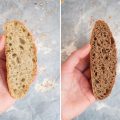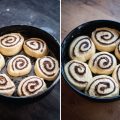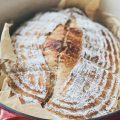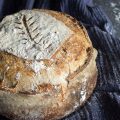When it comes to bread, the choices are seemingly endless. Among the wide array of bread varieties, two standouts often find themselves in the spotlight: ciabatta and sourdough. These types of bread have earned a reputation for their distinct flavors, textures, and culinary applications. As lovers of bread seek the perfect loaf, the debate over whether ciabatta is better than sourdough, or vice versa, sparks intriguing discussions among baking enthusiasts and food connoisseurs alike. In this blog post, we will delve into the characteristics of ciabatta and sourdough, examining their unique qualities, flavors, and potential uses.

Table of Contents
- What is Ciabatta Bread?
- What is Sourdough Bread?
- Is Sourdough or Ciabatta Better?
- Ciabatta vs Sourdough
- How About Sourdough Ciabatta Bread?
- Sourdough Ciabatta Bread Recipe
- So Ciabatta or Sourdough?
- FAQs
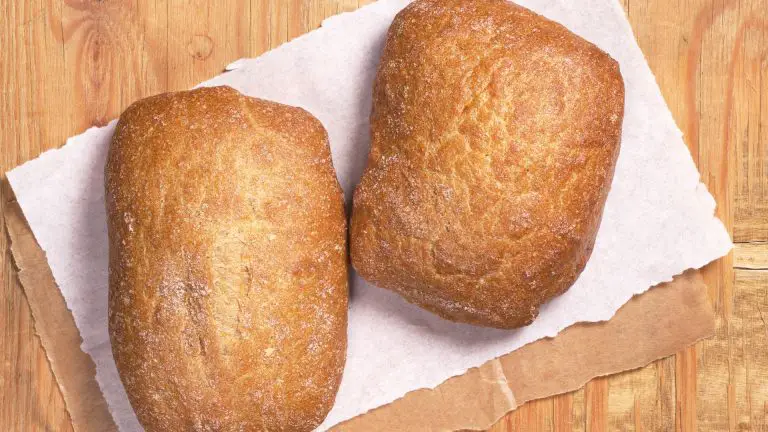
Sourdough Ciabatta Recipe
When you combine sourdough’s tangy flavors with ciabatta bread’s wonderful airy texture, you get an amazing loaf. Perfect for breakfast, lunch, or snack time.
- Total Time: 24 hrs 35 mins
- Yield: 1 loaf 1x
Ingredients
- 400g bread flour
- 100g all-purpose flour
- 350g water
- 100g active sourdough starter (100% hydration)
- 10g salt
Instructions
- In a large mixing bowl, combine the bread flour, all-purpose flour, and water. Mix until the ingredients are incorporated, then let the mixture rest for 30 minutes. This resting period is called autolyze and helps with gluten development.
- After the autolyze, add the sourdough starter to the dough and mix until it is well combined. You can use your hands or a spatula for mixing. Let the dough rest for another 30 minutes.
- Sprinkle the salt over the dough and incorporate it by folding and gently kneading the dough until the salt is evenly distributed. Avoid over-kneading, as this can make the final bread dense.
- Perform a series of stretch and fold techniques to develop the gluten. To do this, wet your hands with water and gently stretch one side of the dough and fold it over the center. Rotate the bowl and repeat this process for each side of the dough. Cover the bowl and let it rest for about 30 minutes.
- Repeat the stretch and fold process three more times, letting the dough rest for 30 minutes between each round. This helps strengthen the dough and develop the desired texture.
- After the final round of stretch and fold, cover the bowl and let the dough ferment at room temperature for 2-4 hours, or until it has visibly risen and is puffy. The fermentation time will depend on the temperature of your environment and the activity of your sourdough starter.
- Once the dough has fermented, transfer it onto a well-floured surface. Be gentle to avoid deflating too much air from the dough. Divide the dough into desired-sized pieces for ciabatta loaves.
- Once the dough has fermented, transfer it onto a well-floured surface. Be gentle to avoid deflating too much air from the dough. Divide the dough into desired-sized pieces for ciabatta loaves.
- Cover the shaped loaves with a damp cloth or plastic wrap and let them proof at room temperature for 1-2 hours, or until they have visibly risen and are slightly puffy.
- Preheat your oven to 450°F (230°C) and place a baking stone or baking sheet on the middle rack to heat up.
- Gently transfer the proofed loaves onto the preheated baking stone or baking sheet. You can use a peel or carefully invert them onto the hot surface. Alternatively, you can bake them directly on the baking sheet they were proofed on.
- Bake the sourdough ciabatta loaves for about 20-25 minutes, or until they have a golden brown crust and sound hollow when tapped on the bottom.
- Once baked, remove the loaves from the oven and let them cool on a wire rack before slicing.
- Prep Time: 10 mins
- Cook Time: 25 mins
- Category: bread
- Cuisine: Italian
Nutrition
- Serving Size: 1 slice
- Calories: 155 kcal
- Fat: 1 g
- Carbohydrates: 30 g
- Protein: 5 g
What is Ciabatta Bread?
Ciabatta means slipper in Italian, which refers to its distinct shape, especially when it is sliced.
Originating in Italy and produced in the 1980s, it is a fairly modern bread. Made with high-gluten wheat flour, and a very wet dough, this type of bread offers a unique texture and flavor, thanks to the addition of olive oil.
Modern ciabatta bakers will use a type of starter, which is very similar to a sourdough bread recipe. However, ciabatta isn’t fermented nearly as long as sourdough bread, so the flavors are further from sourdough’s strong taste tangy taste.
What is Sourdough Bread?
If you’ve been on my blog long enough, you’d have an idea of what sourdough bread is.
Sourdough bread is a type of bread made using a natural fermentation process using a sourdough culture (aka sourdough starter). It is characterized by its distinctive tangy flavor, chewy texture, and rustic appearance.
Is Sourdough or Ciabatta Better?
The preference between sourdough and ciabatta bread often boils down to personal taste, and how it is to be used. That being said both sourdough and ciabatta have their own unique characteristics and are equally as desirable for different reasons.
Sourdough bread is made using a fermented dough, containing wild yeasts and bacteria, which provide a distinct tangy flavor. The fermentation process itself can take several hours or days to produce that wonderful flavor profile.
In comparison to ciabatta bread and its soft, airy interior, sourdough bread has a chewy texture with a slightly sour taste, depending on how long it has been fermented.
Ciabatta is mainly used for sandwiches, paninis, and bruschetta, as its structure can withhold many fillings and toppings. It has a slight sweet flavor, that complements various ingredients.
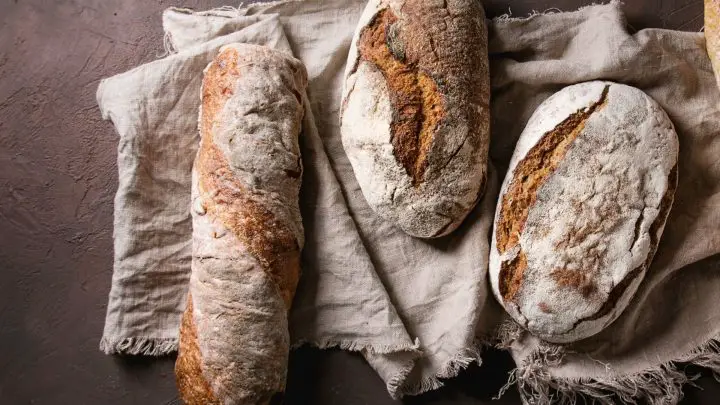
Ciabatta vs Sourdough
While both can be equally as desirable, there are many distinctions that set both ciabatta and sourdough apart. Take a look at some of the differences outlined below:
Taste Differences
Ciabatta bread has a mild flavor with a subtle hint of wheat. It’s not tangy like sourdough, rather it has a more neutral taste. The texture of ciabatta is characterized by its soft and airy interior, complete with a crisp crust that is simply to die for.
On the other hand, sourdough bread provides a unique tangy flavor, thanks to the lengthy fermentation process. Sourdough also tends to have a chewier texture and tougher crust compared to ciabatta.
Calorie Differences
Generally, both ciabatta and sourdough bread have similar calorie ranges. On average a slice of ciabatta bread (50 grams) contains approximately 130-150 calories, while the same slice of sourdough bread can range from 120-150 calories. This is of course dependent on the ingredients used for both recipes.
If you have any specific dietary concerns or requirements, it’s always important to refer to the nutritional information provided by the specific brand or the recipe you’re using.
Recipe Differences
Ciabatta bread and sourdough bread also differ in their recipes and preparation methods:
- Ciabatta bread: Ciabatta dough consists of wheat flour, water, yeast, salt, and olive oil. The dough is mixed, fermented, and proofed before it is shaped into flat, elongated loaves. Ciabatta is traditionally baked on a stone surface or baking sheet, producing a wonderfully crusty exterior and soft interior.
- Sourdough bread: Sourdough requires a sourdough starter, which is essentially a combination of flour, water, wild yeasts, and bacteria. The sourdough starter is fed with additional flour and water until it’s ready to be added to the bread dough. The dough is then fermented to develop flavor and texture. Sourdough bread is often baked at high temperatures to achieve a crusty exterior.
How About Sourdough Ciabatta Bread?
Sourdough ciabatta bread is a combination of the characteristics of both sourdough and ciabatta bread. It incorporates the tangy flavor and chewy texture of sourdough with the soft and airy interior and crispy crust of ciabatta.
Sourdough ciabatta bread is a great choice for those who enjoy the tanginess and depth of flavor that sourdough brings while also appreciating the light and airy texture of ciabatta. It can be used for sandwiches, toasts, or enjoyed on its own.
However, it’s important to note that making sourdough ciabatta bread can require some expertise and experience with sourdough baking, as the process can be more involved compared to regular ciabatta or sourdough bread.
Sourdough Ciabatta Bread Recipe
When you combine sourdough’s tangy flavors with ciabatta bread’s wonderful airy texture, you get an amazing loaf. Perfect for breakfast, lunch, or snack time.
- Type: Bread
- Cuisine: Italian
- Recipe yield: 1 loaf
- Calories: 155kcal
- Preparation time: 10 minutes
- Cooking time: 25 minutes
- Total time: 24H35M
Ingredients
- 400g bread flour
- 100g all-purpose flour
- 350g water
- 100g active sourdough starter (100% hydration)
- 10g salt
Instructions
- In a large mixing bowl, combine the bread flour, all-purpose flour, and water. Mix until the ingredients are incorporated, then let the mixture rest for 30 minutes. This resting period is called autolyze and helps with gluten development.
- After the autolyze, add the sourdough starter to the dough and mix until it is well combined. You can use your hands or a spatula for mixing. Let the dough rest for another 30 minutes.
- Sprinkle the salt over the dough and incorporate it by folding and gently kneading the dough until the salt is evenly distributed. Avoid over-kneading, as this can make the final bread dense.
- Perform a series of stretch and fold techniques to develop the gluten. To do this, wet your hands with water and gently stretch one side of the dough and fold it over the center. Rotate the bowl and repeat this process for each side of the dough. Cover the bowl and let it rest for about 30 minutes.
- Repeat the stretch and fold process three more times, letting the dough rest for 30 minutes between each round. This helps strengthen the dough and develop the desired texture.
- After the final round of stretch and fold, cover the bowl and let the dough ferment at room temperature for 2-4 hours, or until it has visibly risen and is puffy. The fermentation time will depend on the temperature of your environment and the activity of your sourdough starter.
- Once the dough has fermented, transfer it onto a well-floured surface. Be gentle to avoid deflating too much air from the dough. Divide the dough into desired-sized pieces for ciabatta loaves.
- Once the dough has fermented, transfer it onto a well-floured surface. Be gentle to avoid deflating too much air from the dough. Divide the dough into desired-sized pieces for ciabatta loaves.
- Cover the shaped loaves with a damp cloth or plastic wrap and let them proof at room temperature for 1-2 hours, or until they have visibly risen and are slightly puffy.
- Preheat your oven to 450°F (230°C) and place a baking stone or baking sheet on the middle rack to heat up.
- Gently transfer the proofed loaves onto the preheated baking stone or baking sheet. You can use a peel or carefully invert them onto the hot surface. Alternatively, you can bake them directly on the baking sheet they were proofed on.
- Bake the sourdough ciabatta loaves for about 20-25 minutes, or until they have a golden brown crust and sound hollow when tapped on the bottom.
- Once baked, remove the loaves from the oven and let them cool on a wire rack before slicing.
Nutrition
- Calories: 155kcal
- Carbohydrates: 30g
- Protein: 5g
- Fat: 1g
- Saturated fat: 0g
So Ciabatta or Sourdough?
Determining whether ciabatta is better than sourdough is a subjective matter that ultimately comes down to personal preference.
Both ciabatta and sourdough are beloved bread varieties with distinct characteristics that cater to different tastes and purposes.
Other sourdough breads on the blog:
FAQs
Is Ciabatta Healthier Than Normal Bread?
Ciabatta bread is much higher in carbohydrates when compared to other bread, however, the additional fiber, protein, and essential vitamins compensate for this, thus making it a healthier bread.
What is Special About Ciabatta Bread?
Ciabatta is a fairly large bread, with a higher hydration dough, therefore producing very large holes in the bread, The flour used to make ciabatta bread is quite strong, which produces a slightly sweet and delicate taste.
Is Sourdough The Healthiest Bread?
While not the healthiest bread, sourdough is definitely recognized as much healthier when compared to regular bread, thanks to the natural yeasts and good bacteria that contribute to a comfortable and satiated tummy.

